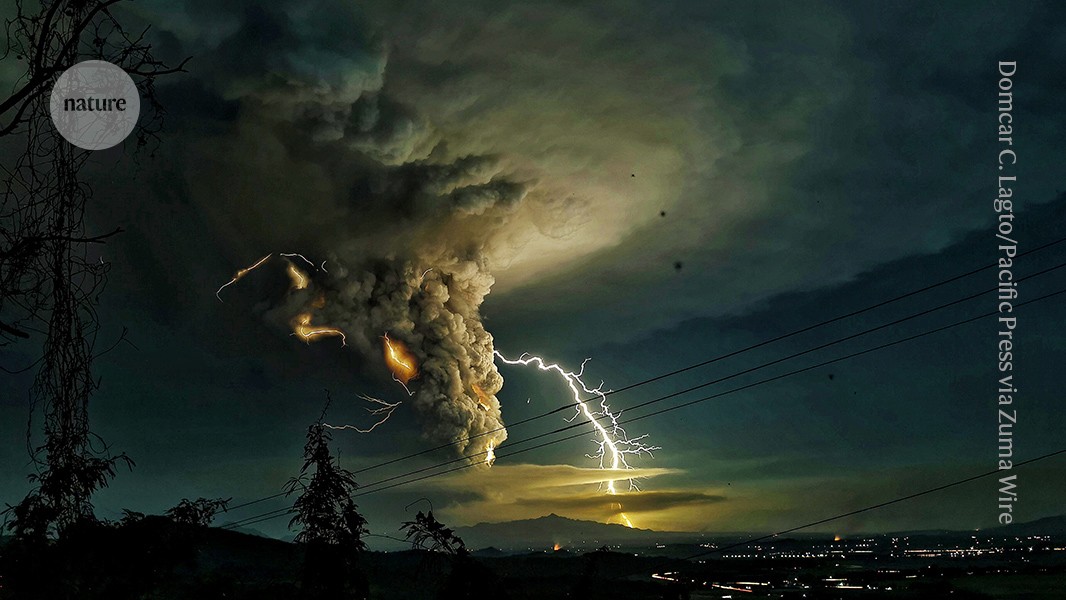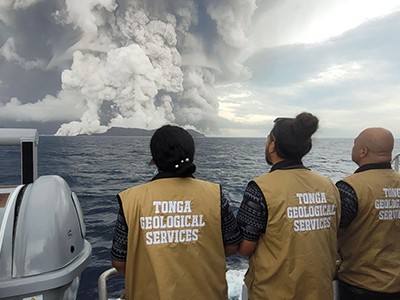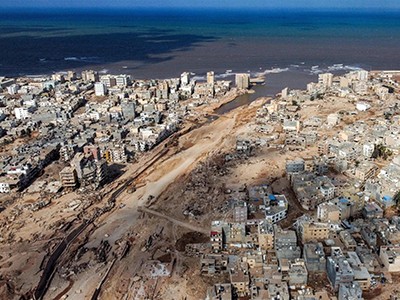Cataclysmic volcanic eruptions are rare — but inevitable. Governments should not only work to stem global warming, but also prepare for other extreme events with a planet-wide impact. The 1815 massive eruption of Mount Tambora in Indonesia should ring alarm bells. Imagine if this happened today.
Around 90,000 people on Sumbawa Island and neighbouring Lombok were killed when Mount Tambora blew. The eruption triggered waves of weather anomalies around the world, which lasted for years and affected millions more people. The Northern Hemisphere cooled by 1 °C and the subsequent year was said to lack a summer. Abnormally cold weather persisted well into 1817 across North America and Europe, resulting in meagre harvests.
A consequent doubling of grain prices led to societal unrest in countries such as France and the United Kingdom, and plunged the United States into its first economic depression. In India, erratic weather was linked to a cholera outbreak, which spread to become a global pandemic in 1817. The ripple effects of the Tambora eruption resulted in a death toll probably in the tens of millions1,2.
Huge volcanic eruptions: time to prepare
The Tamboran gloom has faded, and the world has been spared a volcanic eruption of similar magnitude in more than 200 years. Yet the question is not whether such a cataclysm will occur again, but when. Geological evidence from volcanic deposits over the past 60,000 years suggests a 1-in-6 probability of a massive eruption occurring this century3,4.
If that happened in the next 5 years, the costs would be colossal. In an extreme scenario, the economic impacts would cost more than US$3.6 trillion in the first year and $1.2 trillion more over subsequent years, owing to the effects of extreme weather, reduced crop yields and food instability, according to the insurance and reinsurance market Lloyd’s of London, which assessed these risks in May (see go.nature.com/4ewty2d).
Those are huge values. But they have large uncertainties attached. Scientists understand the basic mechanisms of how volcanism influences climate, but not the fine details: sulfur dioxide (SO2) is propelled into the stratosphere, where it forms sulfate aerosols that reflect incoming solar radiation and cool Earth’s surface5. The magnitude of cooling depends on the amount, vertical distribution and size of these sulfate aerosol particles6. The effects on rainfall are harder to predict, as are those on agriculture and economic markets. And all of these details will be affected by and have an influence on climate change.
To pin down these uncertainties, we call for a three-pronged approach. First, researchers should tie in models and geological evidence for past climates with historical volcanic records. Second, they should explore how volcanic cooling might interact with anthropogenic climate warming. And third, scientists, analysts and policymakers need to design strategies for minimizing the effects of a catastrophic eruption, by coupling climate, crop and food-shock models.
Understand what happened in past eruptions
Researchers don’t have enough evidence to deduce how much sulfur volcanoes have injected into the atmosphere historically, or what its cooling effects were. Satellites have tracked sulfate emissions from volcanoes since the 1991 eruption of Mount Pinatubo in the Philippines. But those from earlier eruptions must be reconstructed on the basis of deposits in ice-core samples from Antarctica and Greenland. Traces are evident from only large eruptions.
Models are then used to estimate how much reached the stratosphere. But assumptions must be made about the volumes injected, the height of the plume and the size of aerosol particles. Even for the Tambora cataclysm — which was ten times larger than Pinatubo — reconstructed stratospheric sulfate levels vary by up to a factor of 15 between models7.
The corresponding cooling is also hard to predict. For example, the 5 massive eruptions that released the most sulfur8 in the past 1,500 years all caused a similar amount of summer cooling in the Northern Hemisphere — around 1–1.5 °C for 2–3 years9 — despite the masses of sulfur they released differing by a factor of 3 (see ‘Volcanoes that changed the world’).
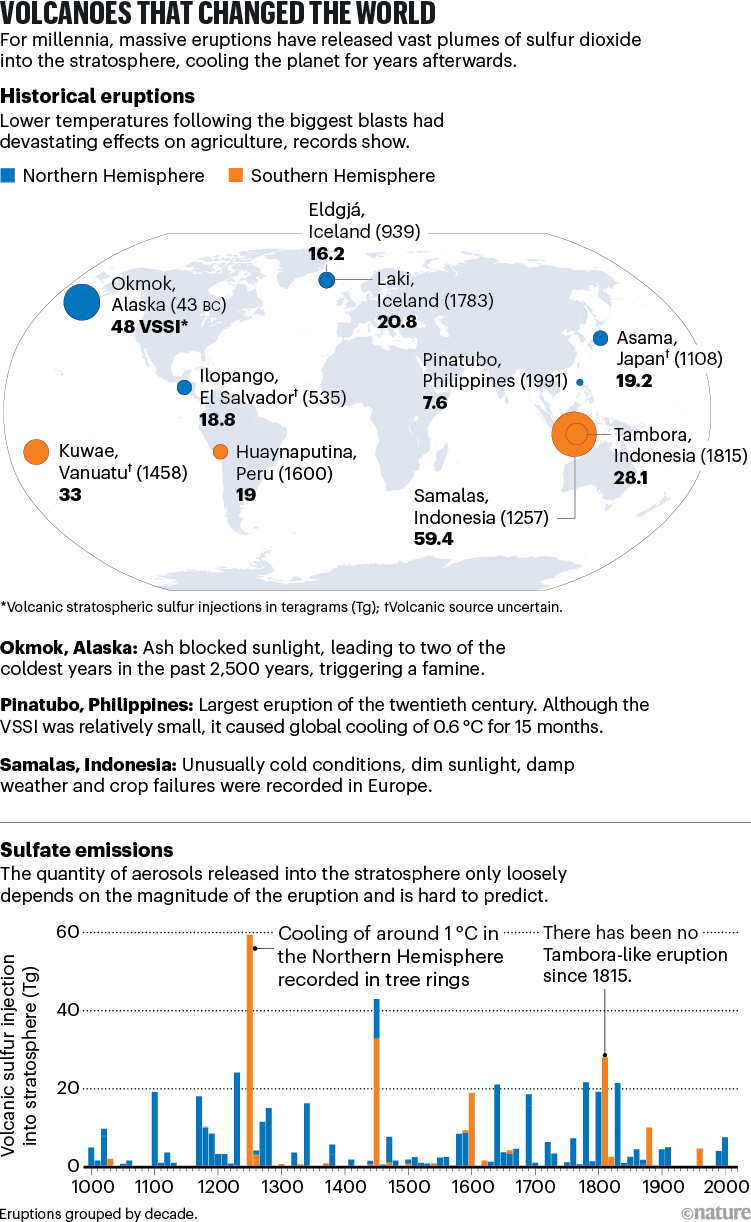
Source: M. Sigl & M. Toohey PANGAEA https://doi.org/10.1594/PANGAEA.971968 (2024).
Such inconsistencies stem from limitations in researchers’ understanding of the lifecycle of aerosols. For example, bigger eruptions might loft larger particles into the air, which are less efficient at scattering radiation and fall out of the stratosphere faster than smaller ones do, resulting in less cooling. The influence of volcanism on regional climate events, such as El Niño and monsoons, is also poorly understood6,10.
To fill these gaps, we appeal to international modelling efforts, such as the Volcanic Forcings Model Intercomparison Project, to explore limiting factors. Models should look at a range of sulfur yields as well as aerosol and sulfur chemistry. They should examine how the impacts of eruptions vary in different climates. And they need to better assimilate and integrate ice-core, tree-ring and other data on past climates to improve the accuracy of simulations and predictions.
Consider volcanic cooling in a warmer world
Modelling of past eruptions can tell us a lot. But, in a hotter world, many physical and chemical processes in the atmosphere, in oceans and on land will also change. For example, global warming heats the lower atmosphere and cools the stratosphere. Alteration of atmospheric layers will affect how volcanic plumes spread and how high they reach11,12.
Changes in circulation patterns will also affect how aerosols spread and grow. For example, faster air flows from the tropics to higher latitudes, which are already observed as a consequence of warming, hamper the coagulation of aerosols from eruptions in the tropics. Smaller aerosols scatter sunlight more efficiently and cool Earth’s surface more11.
The oceans will also be affected. Global warming increases ocean stratification that then acts as a barrier to mixing of deep and shallow waters. Volcanic eruptions might thus disproportionately cool the upper layers of water and the air masses above the ocean.
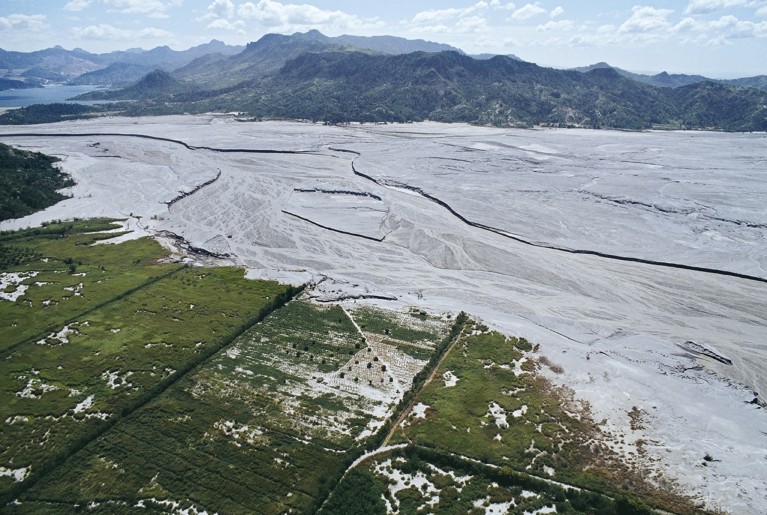
Ash slurry covered a valley near Mount Pinatubo after it erupted in the Philippines in 1991.Credit Marc Schlossman/Panos Pictures
And as climate extremes mount — from heavy rainfall to melting ice sheets and sea-level rise — the ramifications of volcanic activity will only grow, making it essential to get a handle on them now. Researchers need to understand how eruptions amplify or dampen anthropogenic climate change11.
Disaster early-warning systems are ‘doomed to fail’ — only collective action can plug the gaps
Yet, none of these details is included in current climate models, which assume that volcanism in the twenty-first century will resemble past activity12. Moreover, Tambora’s eruption lies outside the 1850–2014 range of historical volcanic records that feed into standard climate projections, such as the Coupled Model Intercomparison Project (CMIP6) outputs used in the Sixth Assessment Report of the Intergovernmental Panel on Climate Change. Thus, these simulations both underestimate the effects of volcanism on the climate and the frequency of massive volcanic eruptions.
We appeal to researchers developing the next generation of climate models (including CMIP7) to build in more-accurate representations of volcanism. They should improve models of historical eruptions not covered by satellite data, future trends in a warming climate and microphysical processes in the stratosphere. In-depth simulations of multiple eruptions in different climate scenarios would widen the range of impacts considered.
Forecast the socio-economic impacts of a massive cataclysm
As well as happening in a warmer climate, the next Tambora-like eruption will occur in a more interconnected world that supports eight times the population of 1815. Agricultural systems would suddenly face lower levels of sunlight, cooler weather and altered moisture patterns — all in close succession. Outsized societal impacts might follow.
For example, the 1991 Pinatubo eruption resulted in a 9% reduction in global maize (corn) yields and a 5% reduction in wheat, rice and soya-bean production13. Crop failures from a more massive eruption would hit global breadbasket regions simultaneously — China, the United States, India, Russia and Brazil, which together produce most of the world’s wheat, maize, rice and soya beans. Loss of harvests would disrupt global food security and supply chains, potentially triggering unrest, conflict and migration.
Since the 1990s, climate simulations have been coupled to crop models to project the likely impacts of global warming on yields and food trade. Synchronized breadbasket failures have been considered in light of the increasing frequency and intensity of weather extremes14.
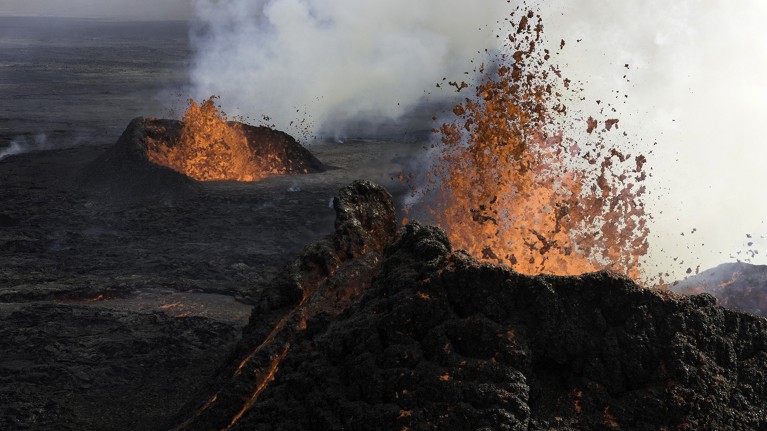
Lava from the Sundhnúkur volcano near Grindavik, Iceland, in June 2024.Credit: John Moore/Getty
Yet, comparable analyses are lacking for volcanic eruptions, for which the focus has remained on the effects that medium-scale eruptions such as Pinatubo or climate engineering could have on global agriculture13. This research gap leaves governments and policymakers in the dark.
We call for a coupling of state-of-the-art climate projections and agricultural models to shed light on this blind spot, ideally through assessments of high-impact cascading shocks by the World Climate Research Programme. Results could be used to assess international trade networks and food reserves to improve understanding, and to predict more-realistic shifts in the global food trade system following major disruptions.
We acknowledge that such a top-down approach is imperfect and that different sources of uncertainty can intensify and cascade at each step. The timing, location and plume height of the next cataclysmic eruption and the state of the climate at that time will remain unpredictable.
Santorini’s volcanic past: underwater clues reveal giant prehistoric eruption
Because of those multiple unknowns, one cannot rely on conventional ‘predict-then-act’ frameworks, because neither forecasts nor uncertainties can be quantified with precision15. Risk managers — including insurers and reinsurers — cannot simply depend on single, best-guess paths.
Instead, we call for a definition of robust decision-making approaches and storylines of extremes to explore worst-case scenarios and to link management decisions to the widest possible range of plausible outcomes.
We recommend a ‘downward counterfactual approach’, which reimagines known past events to construct a realistic view of future risks. For example, by considering a Tambora-scale eruption occurring in today’s climate (perhaps coinciding with an El Niño), insurers and reinsurers could estimate financial losses from systems known to have been affected by past eruptions, such as food trade16.
Relevant businesses and other large financial institutions should also conduct capital stress tests to explore the macroeconomic consequences of a modern year without a summer. We call for the insurance sector to formally consider the risk posed by a Tambora-like eruption as a ‘compulsory event scenario’ in its realistic-disaster scenarios.
A massive volcanic eruption is bound to happen one day. Developing robust models and stress tests for such an event must be a priority for societies, governments and the risk industry so that humanity is adequately prepared for a future cataclysm.


